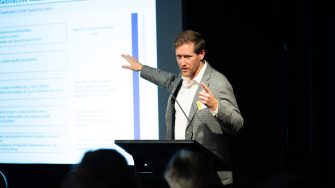2023 Mitsubishi Lecture dives into the complexity of Sustainability in the New Green Economy
The 34th Annual Mitsubishi Sustainability Lecture was held at the UNSW School of Minerals and Energy Resources Engineering on 18 July 2023.
The 34th Annual Mitsubishi Sustainability Lecture was held at the UNSW School of Minerals and Energy Resources Engineering on 18 July 2023.

The 34th Annual Mitsubishi Sustainability Lecture was held at the UNSW School of Minerals and Energy Resources Engineering on 18 July 2023. Speaker Nate Smith, Managing Director and CEO of Tellus Holdings, considered hard questions around what “sustainability” means in the realm of green technology and decommissioning when hazardous waste and recycling are added to the mix.
The key point in the lecture was that the Green Economy and the Environment, Social and Government Framework (ESG) are not fully considering the impact of hazardous materials in their narratives.
“Currently, sustainability, ESG and waste hierarchy frameworks only consider a small sliver of a solutions’ or new processes’ environmental impact, which makes defining end-to-end sustainability difficult. This is particularly true when waste products or remediation requirements are added to the mix,” said Smith.
“Hazardous waste is an issue across nearly all industries, and the shift to a green economy will further increase hazardous waste output,” he said.
“Every green technology, and even the remediation of older fossil fuel technologies and facilities, create challenging waste streams that must be sustainably and safely managed as part of our efforts to make the world a better place.”
This is especially relevant to Australia, as our nation is one of the highest emitters of hazardous waste per capita. Australia generates 8Mt reported waste per year, growing at over 6% per year, but this number does not account for unreported waste and waste stored on-site.
Low-level radioactive waste (LLW) is a large and growing challenge in Australia. Radioactive material is used across various fields, including medicine, industry and research, to study living organisms, diagnose and treat diseases, sterilise medical instruments and food and monitor processes in all industries. Various critical minerals mining and processing techniques also generate large volumes of LLW each year.
Smith considers various options to solve our impactful problems concerning hazardous materials like radioactive waste and PFAS. Tellus’ Sandy Ridge is Australia’s first commercial geological repository and disposal location for low-level radioactive material. It is located approximately 240 kilometres northwest of Kalgoorlie, Western Australia, and sits on one of the earth's oldest, dryest and most stable rock formations. It is licensed to dispose of nearly all hazardous materials, including LLW, mercury and other contaminants.
“Transitioning to net zero is a worthy goal, but we need to be realistic about the costs and impacts, including waste. Waste needs to be part of the overall planning stage of new projects, legislation and regulation, and needs to be funded. Waste is inevitable, so the focus should be on how we can be green,” he said.
Professor Ismet Canbulat, Head of the School of Minerals and Energy Resources Engineering, said, “the Annual Mitsubishi Lecture Series acknowledges the support of Mitsubishi Development Pty Ltd for mining education. Mitsubishi Development is supporting minerals tertiary education at UNSW through various initiatives, including undergraduate scholarships and an annual public lecture on a topical aspect of mining sustainability and support for educational infrastructure in the School”.
The lecture was widely attended by students, staff, alumni and external guests, who had the opportunity to network over refreshments afterwards.